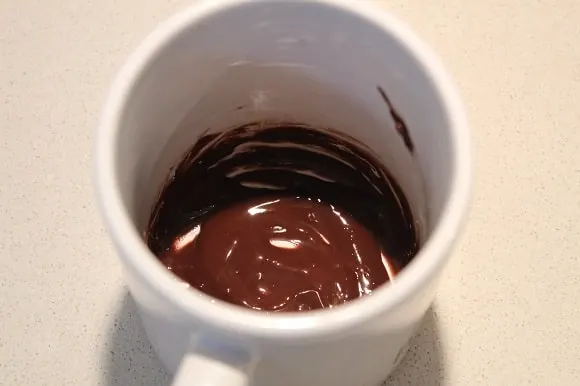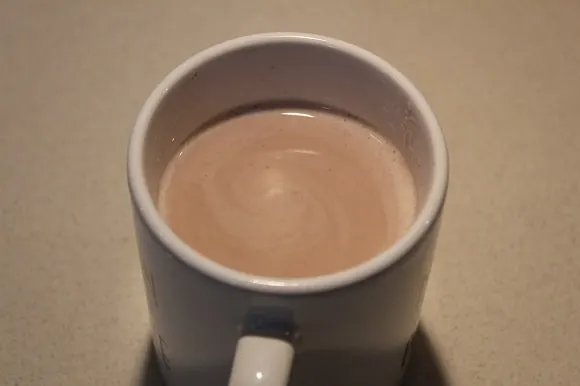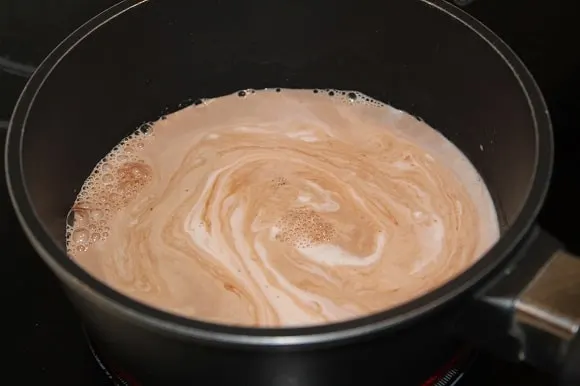We have all been there; you want to enjoy a nice cup of hot chocolate and end up with a bunch of those dry clumps.
Cocoa powder just does not seem to want to mix. But why exactly does cocoa powder clump?
Cocoa powder contains a considerable amount of fat molecules, which are hydrophobic and hence repel water. Additionally, the starch in the cocoa prevents liquid from entering the dry pockets, creating those horrible clumps in your hot chocolate.
There is, however, an easy trick to make smooth and lump-free hot chocolate every time. So keep reading this article to find out more!
Why Does Cocoa Powder Not Dissolve?

Cocoa powder is what remains after cocoa beans have been fermented, roasted, and pressed to extract cocoa butter.
This leftover cocoa product still contains a considerable amount of cocoa butter (fat). Most commercial cocoa powders have a fat content of 8 to 26%.
The cocoa powder’s fat makes it not dissolve well in water or milk, as oils and fats are hydrophobic.
Hydrophobic substances repel or do not absorb water well, which is exactly what happens when you mix cocoa powder with water (or milk, for that matter).
The fat molecules inside the powder repel the water molecules and, as they are surrounded by starch, which acts as a seal on the outside, stick together, creating those dreaded dry pockets you get when adding cocoa to your water or milk.
Of course, you could just go for a cocoa powder with a lower fat content, but (of course, there’s a but), less fat content in cocoa powder also means less chocolate flavor, which is something you want to avoid when trying to make a rich and tasty hot chocolate.
So, we’re back to our original problem: clumping cocoa powder!
A study has found that the dispersion rate of cocoa powder in water depends on three main factors:
- stirring speed
- temperature
- concentration of powder in water
As I’ve already discussed, cocoa powder with a higher fat content will be harder to dissolve in water. So will an increased amount of it.
But what about stirring speed and water temperature?
Does Cocoa Powder Dissolve Better in Hot Water or Milk?

The study mentioned above further found that cocoa powder does dissolve better in high water temperatures and at an increased stirring speed.
There are, however, two significant problems with these findings (unless you’re a scientist with a lab):
1) According to the study, the optimal stirring speed to disperse the cocoa powder in hot water is 630 rpm, which is pretty fast and impossible to achieve with a fork or whisk. You could, of course, use a high-powered hand mixer, but that is a lot of extra work and can get pretty messy.
2) Even at a high water temperature, cocoa powders with a fat content of 20% or more (which is what you’ll want to use for your hot chocolate or chocolate milk) still won’t fully dissolve.
So, even if you mix your cocoa powder with hot water or milk, the problem still remains; cocoa clumps!
How Do You Keep Cocoa Powder From Clumping?
To avoid those nasty clumps in your hot chocolate or chocolate milk, you will have to mix the cocoa powder with just a little hot milk or water!
That’s the whole secret, really!
Remember how all the powder’s fat and starch stick together and seal off the liquid, creating those horrible dry pockets that you just aren’t able to dissolve?
Well, that’s because those lumps have way too much space in all that liquid, allowing them to avoid your spoon, fork, or whisk.
So here’s what you have to do instead:
For Instant Hot Chocolate

1) Put the instant mix into your mug
2) Add just 1 tablespoon of heated water or milk
3) Stir until you get a smooth paste that’s free of lumps
4) Add in the rest of the milk or water and stir

For Homemade Hot Chocolate

1) Add 1 tablespoon of cocoa powder, 1-2 teaspoons of sugar, and a pinch of salt to a saucepan
2) Add 2 tablespoons of milk
3) Turn on the heat (keep it low)
4) Stir until the mix is smooth and free of lumps
5) Add the remaining milk to the pan (turn up the heat to medium)
6) Add 1/2-1oz of chocolate chips and about 1 teaspoon of vanilla extract for extra flavor (if you like)
7) Keep stirring until everything is melted and well mixed
PRO TIP: Avoid letting the milk boil, as this will alter its flavor!

You see, adding only a little bit of water or milk to the cocoa powder won’t allow the starch bubbles to move around in the liquid.
On the other hand, it’ll allow you to easily pop those dry bubbles, expose them to the water or milk, and hence prevent any powder clumps from being created in the first place. Brilliant, isn’t it?
RELATED READING: Does Adding Salt to Your Homemade Hot Chocolate Really Make it Taste Better?
The resulting paste is practically 100% lump-free, smooth, and liquid enough to easily mix with the rest of the water or milk you’ll add next.
So, whether you’re making hot chocolate for yourself, friends or family, or your customers, you’ll always end up with the perfect hot chocolate!
Related Articles
- Is Cocoa Powder the Same Thing as Dark Chocolate Powder?
- How to Sweeten Cocoa Powder (4 Simple Ways)
- Why Does Dark Chocolate Taste So Bitter?


Leave a comment